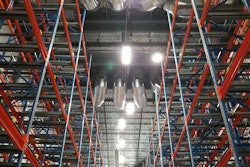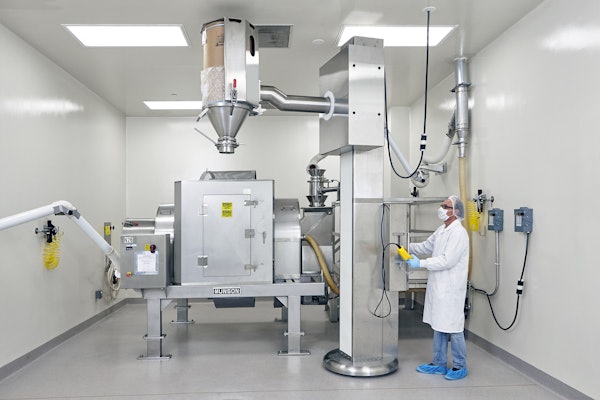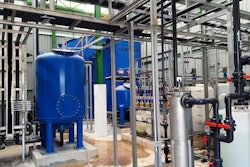Imagine deciding to build a new food plant years before you determined the source of your raw materials supply. Then, imagine choosing your new plant startup date three years in advance and actually achieving startup on the exact date.
While it may seem like a pipe dream, it’s a reality at Clemens Food Group’s new 650,000-sq-ft hog processing facility in Coldwater, Michigan. With startup in September 2017, Clemens’ Coldwater facility was honored at the ProFood Live! conference in June as one of ProFood World’s 2018 Manufacturing Innovation Award winners.
“How we began this project is a little bit different than some other industries,” states Eric Patton, vice president of operations for Clemens Food Group. The Hatfield, Pennsylvania-based pork processor saw an opportunity in Michigan, which would allow hog producers to keep their products local and not haul hogs a significant distance out of state.
At the same time, Clemens needed a larger hog supply for further processing at its existing facility in Pennsylvania. Before the Coldwater facility was built, hogs were leaving Michigan and heading to Indiana or Kentucky for harvesting. Today, hogs are supplied to Coldwater in a 200-mile radius from three states.
“To maintain the growth of value-added products, we had to expand our raw materials supply,” Patton explains. Because its customers value control of raw materials, Clemens did not want to buy products on the open market for the new plant, he states. At its headquarters plant located about 30 miles north of Philadelphia, Clemens processes 90 percent of the available local hogs and produces value-added products, such as hams, bologna, bacon and sausages. The new Coldwater site has no further processing and produces fresh meats, such as pork cuts, butts, loins, hams and bellies, with the other cuts going to Hatfield for further processing.
“If you look at the technologies, equipment and process we put in place, it’s all geared toward product quality,” says Randy Zorn, general manager of Clemens’ Coldwater facility. “Certainly, snap chills and equilibration bays have always been in the industry, but the processes we put in place are much more fine-tuned, [along with] the tonnage of refrigeration and succinct control of carcass temperature.”
Using snap chill technology, Clemens is able to achieve temperature targets rapidly and control product shrink in the coolers. “We are getting shrink levels that are very favorable without having to put any kind of water on the carcasses,” Zorn adds.
Key aspects of design
Drivers who deliver the hogs never enter the facility, and trucks are washed on site after delivery. Renowned livestock expert Temple Grandin helped design the hog receiving system, clear up to the CO2 stunning, says Zorn. Grandin also verified that the process was built to her specifications.
Fully inspected and approved hog carcasses enter a -25°F snap chill freezer for 90 minutes. The freezer includes a 3,128-ft chain, which is the longest and fastest in the world. From there, the carcasses go through an equilibration cooler, equipped with automated sortation, where they rest for 24 hours. The refrigeration system in the equilibration cooler is a patented chilling system that minimizes meat shrinkage. This process ensures only .5 percent shrinkage or less to maintain moisture in the meat. Additionally, the equilibration cooler helps maintain the proper color of the meat.
At the Coldwater facility, all the trimmings and waste from the harvest floor are gathered through an extensive vacuum system and sent to the rendering area. Here, the trimmings are turned into dry meal and grease, using Haarslev processing technology. This equipment was coordinated in the design phase of the project through 3-D modeling, according to Bharath Singh, project director at Gray Construction, Clemens’ engineering management partner on the project.
Several key aspects that Clemens sought during the facility design were reducing the manual labor of lifting heavy boxes, reducing congestion of powered industrial truck traffic and improving the integrity of product packaging. A fully automated material handling system was designed to transport empty boxes to pack stations and then transport full boxes away from the pack stations to a fully automated weigh label and sealing operation, with six machines from Sealed Air in place.
Full pallets are conveyed into the automated refrigerated and storage warehouses, where mechanical cranes induct them into racks for storage awaiting shipment orders. Once ordered for shipment, the cranes automatically retrieve the desired pallets and convey them to the dock for loading on carriers for shipment.
The facility includes five packaging lines with 26 separate packaging stations, providing increased flexibility. Six case erectors feed the pack stations, where, once boxed, 20,000 or more cases per shift are moved on a conveyor system to the label mezzanine for automatic weighing, sealing and labeling operations.
The boxes then travel to the accumulation and sortation mezzanine, where fresh meat is sent for palletizing and to the automated storage and retrieval system (AS/RS) cooler. The boxes with frozen meat go to the GEA variable retention time (VRT) freezer that is customized for various products with different chilling and freezing profiles. This freezing process typically takes 24 hours or less, while traditional systems require 48-72 hours. “By embracing VRT, Clemens is able to respond more quickly to market demand, lower its inventory, reduce product loss and decrease labor costs since the system is automated,” according to Jeff Scott, senior project manager at Gray Construction.
The AS/RS is nine positions high, consists of more than 7,000 positions in inventory, is serviced by five cranes, provides a smaller overall footprint, and allows Clemens to store and retrieve finished product with minimal human intervention. The large freezer system is designed to allow product to be shuffled automatically during off hours, ensuring for automatic optimization for first in, first out storage and retrieval. The design also has the potential for automatic inventory checking based on the unique design of the transfer systems, providing material handling management all the way to the dock.
Automation gains lower labor costs
At the Coldwater facility, equipment and software integration is tied from the plant floor to the business office. Production orders are downloaded daily from the main enterprise resource planning system to the automation layer, which allows for automated delivery of necessary products around the facility, according to Walker Mattox, president of GraySolutions, a sister company to Gray Construction. Constant communication with the warehouse management system provides inventory synchronization, delivering real-time information for sales and production teams.
Automation advances throughout the new facility include:
• A sophisticated AS/RS that improves material handling and worker safety.
• Automated scaling and sorting systems to assure products meet precise weight requirements.
• VRT incorporated into the freezing process to increase efficiency and production, decreasing the typical meat-freezing process from a three-day waiting period to less than 24 hours — optimized according to specific product and case sizes.
• A patented equilibration cooler better controls carcass shrinkage and extends shelf life.
• Waterjet cutting for improved processing of pork bellies for more precise cuts and higher yields.
• Steam scalding for food safety and reducing water utilization.
• Automatic splitting saws that eliminate human errors and enhance worker safety.
• Automatic loin puller for more precise cuts and higher yields.
Compared to similar facilities, these automation upgrades allow Clemens Food Group to produce the same volume of fresh pork with approximately 300 fewer employees. While these systems required a large capital investment, Clemens believes they will pay back in lower ongoing labor costs, improved safety and an enhanced working environment for team members.
“We can track and know where a carcass is at any particular time,” states Zorn. “It ties into our Ignition system, so we can constantly monitor aspects of our system, such as boilers, cookers, rendering, scales, etc.” All needed data can be pulled from Inductive Automation’s Ignition supervisory control and data acquisition system.
According to Zorn, problem resolution happens fairly quickly. Technicians can dive into the programming and see what is causing stoppages or issues. In addition, the facility has 24/7 online assistance from “just about everybody that supplies equipment to the location,” Zorn adds.
The plant also uses JDA software to communicate from its warehouse control system warehouse process to its SAP system. “That’s where we can look at opportunities or potential gaps in our yield capabilities that we need to focus on,” he adds.
Efficient, sanitary and sustainable
The plant features a straight, streamlined layout. Pigs come in from the north, and boxes come out of the south side of the facility. Walls are sealed and coved; temperature control is closely monitored so the effects of issues like condensation can be minimized. “All of those make big differences in the way the plant is able to be cleaned and sanitized,” states Zorn.
Unlike similar plants, there is no basement. “Production waste is pumped to our inedible location,” explains Zorn. “There are no open augers moving product down long hallways and into a basement,” he adds. This practice eliminates facility odors.
The Frontmatec pork processing system on the cutting floors can be turned on for initial washdown. All processing lines directly feed the packaging lines. “Product does not have to move four rooms over into another packaging area. It goes immediately from the processing lines, into the packaging lines, into the weigh/label system, and then into the sortation system, and eventually into the cranes,” says Zorn.
Using the AS/RS, product is automatically picked with the crane system and delivered to the warehouse. The only place you see team members is when they are loading trucks from the shipping lanes.
The Coldwater facility features a rendering area with a heat recovery system. When the trimmings and other material enter the raw materials bin, they travel to the cooker, where they are heated and further separated into usable product. The heat generated during the cooking process is used to heat water to be used in the sanitation process and is stored in three 150,000-gal water tanks located outside the facility.
Clean-in-place and clean-out-of-place technology is integrated throughout the facility. Wash-down stations, including hosing and foaming functionalities, are also located throughout to enable complete cleaning of equipment and building surfaces. A medium-pressured wash-down system reduces atomization of residual meat during the sanitation process. Between the time the carcass leaves the clean harvest floor and is received in the cut floor, there is no human intervention, removing the risk of contamination. Also, between packaging and end consumer, human involvement is minimal. Additionally, air curtains at critical product transfer openings ensure air migration between areas is controlled.
Improved data collection is key to government reporting guidelines. The Food Safety and Inspection Service (FSIS) uses hazard analysis and critical control points (HACCP) as a framework for inspecting food processing plants for safety and food quality. As part of a new Modernization of Pork Slaughter rule passed last year, USDA launched a pilot program called HIMP (HACCP inspection models project). The program has been described as an inspection system in which packing plants adhere to a greater responsibility for carcass inspection. In addition, FSIS employees ensure the inspections are enforced effectively and focus on other food safety verification tasks. Clemens Food Group is among a small group of pork processors participating in HIMP, and its employees are thoroughly trained in performing tasks that USDA used to do. “That gives USDA more time to do offline inspection throughout the facility and also look at our records, just to ensure that we are in control of our process,” states Zorn. “It allows us to produce at a higher rate.”
A steam direct inject system is used as a secondary system for Clemens to maintain the correct temperature during sanitation. Instead of lagoons, the Coldwater facility has an on-site wastewater treatment plant for production wastewater. “This allows Clemens to reuse a sizeable portion of the treated water for nonfood production processes, such as the misters in the hog pens and reuse water for rescrubbing and three of the four dehairing operations,” says Gray Construction’s Scott.
“If you look at the technologies that are applied for our boiler controls, combustion, all of that is monitored to a very fine degree. Our hot water is on time delivery. All of our cardboard is recycled. And many of the bio solids coming from our wastewater are going to digesters,” explains Zorn. “The main thing is that we’re able to separate out our waste streams much more efficiently than I’ve seen in the past,” he adds.
To avoid negative impact on neighboring properties, the plant uses air scrubbers to neutralize the air in order to remediate odors.
Worker welfare and staffing
Doug Clemens, CEO of Clemens Food Group, wanted to ensure team members were comfortable and equipped with as many amenities as possible. Pleasant locker rooms were created, and dining areas include USB charging stations, inside and outside seating options, and an abundance of natural light.
On the plant floor, ergonomics was integrated into the design by installing workstations with adjustable standing platforms for proper reachability, tool retractors to reduce muscle fatigue, and proper floor traction to reduce slippage and fatigue.
“The one-size-fits-all mentality was not an option,” says Gray Construction’s Singh. The design accounted for each workstation and the safety of the person at that station.
The ease of employee flow is an important design aspect of the new facility. With more than 800 employees entering the building each morning, efficient flow is paramount to reducing wait times for lockers and donning personal protective equipment. This flow is especially important during break times and meal times.
To properly staff and train new employees, Clemens purchased another building in Coldwater to serve as its training center. This facility holds more than 75 people, allowing many from the Hatfield operation to visit and train the new staff.
Long before production started, Clemens chose its “Golden 200” employees. The company selected them to go to the Hatfield headquarters for several weeks to train for leadership positions alongside seasoned employees.
According to Patton, the project’s success story is all about the people involved. “We have processed product in this industry for 125 years. We never did anything like this, and it came down to getting the right people, valuing them, listening and having trust in them, and them trusting us. That is what gets you to the end game,” states Patton.
With the right team in place, Clemens made its strategic vision in Coldwater a reality.






















